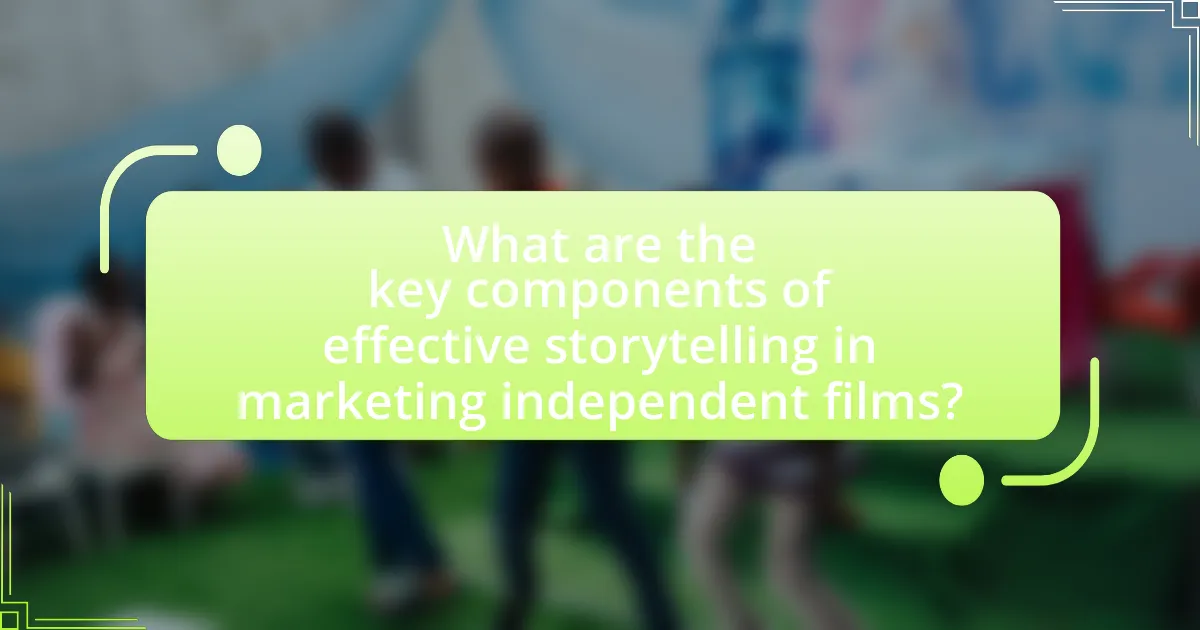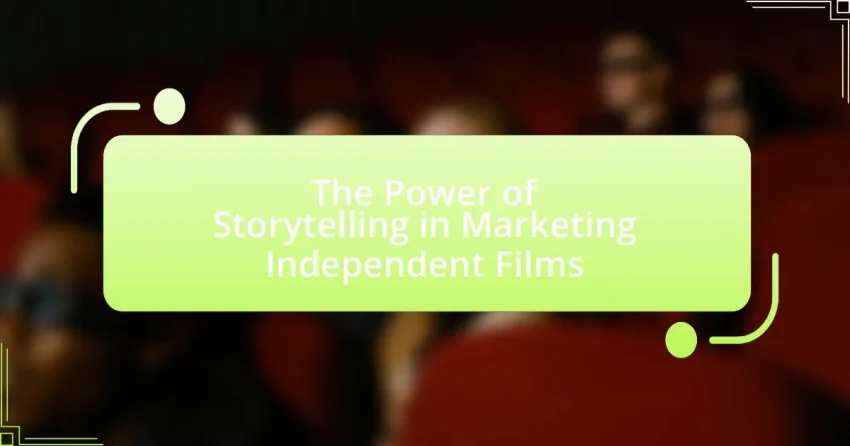The article examines the significance of storytelling in the marketing of independent films, emphasizing its role in creating emotional connections with audiences and enhancing viewer engagement. It highlights how effective narratives can differentiate independent films in a competitive market, increase audience retention, and influence viewer decisions. Key components of successful storytelling, such as character development, emotional resonance, and narrative structure, are discussed, along with strategies for leveraging storytelling across various marketing channels, including social media. The article also addresses the challenges faced by independent filmmakers without strong narratives and outlines best practices for implementing storytelling in marketing efforts.

What is the Power of Storytelling in Marketing Independent Films?
The power of storytelling in marketing independent films lies in its ability to create emotional connections with audiences, driving engagement and interest. Effective storytelling allows filmmakers to convey their unique vision and themes, making their films relatable and memorable. For instance, a study by the University of Southern California found that narratives can increase audience retention by up to 65%, highlighting the importance of a compelling story in capturing viewer attention. Additionally, storytelling can differentiate independent films in a crowded market, as it provides a distinctive voice that resonates with potential viewers, ultimately influencing their decision to watch the film.
How does storytelling influence audience engagement in independent films?
Storytelling significantly influences audience engagement in independent films by creating emotional connections and fostering relatability. Engaging narratives allow viewers to immerse themselves in the characters’ journeys, enhancing their investment in the film’s outcome. Research indicates that films with strong storytelling elements, such as character development and plot complexity, can lead to higher viewer retention rates and positive word-of-mouth promotion. For instance, a study published in the Journal of Media Psychology found that audiences are more likely to recommend films with compelling stories, demonstrating the direct correlation between storytelling quality and audience engagement metrics.
What elements of storytelling resonate most with viewers?
Emotional connection is the element of storytelling that resonates most with viewers. This connection is often established through relatable characters, compelling conflicts, and universal themes that evoke empathy and understanding. Research indicates that stories that elicit strong emotional responses can increase audience engagement and retention, as demonstrated by a study published in the journal “Psychological Science,” which found that emotionally charged narratives are more memorable and impactful than neutral ones. Additionally, the use of vivid imagery and sensory details enhances the viewer’s experience, making the story more immersive and relatable.
How does emotional connection enhance the effectiveness of storytelling?
Emotional connection significantly enhances the effectiveness of storytelling by fostering engagement and relatability among audiences. When stories evoke emotions, they create a deeper bond between the narrative and the audience, making the content more memorable. Research indicates that emotionally charged stories can increase information retention by up to 65%, as emotions trigger the brain’s limbic system, which is responsible for processing feelings and memories. This connection not only captivates the audience but also drives them to take action, such as sharing the story or supporting the film, thereby amplifying its reach and impact in marketing independent films.
Why is storytelling essential for independent film marketing?
Storytelling is essential for independent film marketing because it creates an emotional connection with the audience, making the film more relatable and memorable. This connection is crucial in a crowded market where independent films often compete against larger productions with bigger budgets. By crafting a compelling narrative around the film’s themes, characters, and unique selling points, marketers can engage potential viewers and generate interest. Research indicates that stories are 22 times more memorable than facts alone, highlighting the effectiveness of storytelling in capturing attention and fostering audience loyalty.
What challenges do independent films face without strong storytelling?
Independent films face significant challenges without strong storytelling, primarily including a lack of audience engagement and difficulty in securing funding. Weak narratives fail to captivate viewers, leading to poor box office performance; for instance, films with compelling stories often see higher audience retention rates, while those lacking narrative depth struggle to maintain interest. Additionally, investors are less likely to support projects that do not demonstrate a clear and engaging storyline, as evidenced by industry trends showing that films with strong scripts attract more financial backing. Consequently, the absence of strong storytelling directly impacts both the commercial viability and creative success of independent films.
How can storytelling differentiate independent films from mainstream productions?
Storytelling differentiates independent films from mainstream productions by allowing for unique narratives that often explore unconventional themes and character development. Independent films frequently prioritize personal, intimate stories that reflect diverse perspectives, whereas mainstream productions tend to focus on broad appeal and formulaic plots designed for mass consumption. For example, films like “Moonlight” and “Lady Bird” showcase intricate character arcs and social issues that resonate on a personal level, contrasting with the blockbuster approach of franchises like “Transformers,” which emphasize spectacle over substance. This distinct storytelling approach in independent cinema fosters deeper emotional connections with audiences, setting them apart from their mainstream counterparts.

What are the key components of effective storytelling in marketing independent films?
The key components of effective storytelling in marketing independent films include a compelling narrative, relatable characters, emotional engagement, and a clear message. A compelling narrative captures the audience’s attention and drives interest, while relatable characters allow viewers to connect personally with the story, enhancing their investment in the film. Emotional engagement is crucial, as it evokes feelings that resonate with the audience, making the film memorable. Lastly, a clear message provides a takeaway that reinforces the film’s themes and values, guiding marketing strategies. These components are supported by successful independent films that have utilized storytelling to build strong audience connections and drive box office success.
How do character development and narrative structure impact marketing?
Character development and narrative structure significantly impact marketing by enhancing audience engagement and emotional connection. Well-developed characters create relatable and memorable experiences, which can lead to increased brand loyalty and consumer trust. For instance, a study by the Journal of Advertising Research found that storytelling in advertisements, particularly those featuring strong character arcs, can boost viewer retention by up to 55%. Additionally, a coherent narrative structure helps convey the brand message effectively, making it easier for audiences to understand and relate to the product or service being marketed. This alignment between character-driven narratives and marketing strategies can ultimately drive higher conversion rates and sales in independent films.
What role do protagonists play in attracting an audience?
Protagonists play a crucial role in attracting an audience by serving as relatable figures that embody the central themes and conflicts of the story. Their development and journey create emotional connections, drawing viewers into the narrative. Research indicates that audiences are more likely to engage with films that feature well-crafted protagonists, as they provide a lens through which viewers can experience the story’s emotional highs and lows. For instance, a study published in the Journal of Media Psychology found that characters with depth and complexity significantly enhance viewer investment, leading to increased interest and retention. This demonstrates that effective protagonists are essential in capturing and maintaining audience attention in independent films.
How can plot twists enhance viewer interest in marketing campaigns?
Plot twists can significantly enhance viewer interest in marketing campaigns by creating unexpected moments that capture attention and provoke emotional responses. These surprising elements engage audiences, making them more likely to remember the campaign and share it with others. Research indicates that narratives with plot twists can increase viewer retention by up to 70%, as they stimulate curiosity and encourage deeper cognitive processing. This heightened engagement leads to a stronger connection with the brand, ultimately driving consumer action and loyalty.
What techniques can filmmakers use to craft compelling stories for marketing?
Filmmakers can use techniques such as character development, emotional resonance, and narrative structure to craft compelling stories for marketing. Character development allows audiences to connect with relatable protagonists, enhancing engagement. Emotional resonance taps into feelings, making the story memorable and impactful; for instance, a study by the University of California found that emotionally charged narratives increase viewer retention by 65%. Narrative structure, including the use of conflict and resolution, creates a compelling arc that keeps audiences invested. By employing these techniques, filmmakers can effectively market their independent films and attract a wider audience.
How can visual storytelling be integrated into marketing strategies?
Visual storytelling can be integrated into marketing strategies by utilizing compelling imagery and narratives that resonate with the target audience. This approach enhances emotional engagement, making the marketing message more memorable. For instance, brands can create short films or video content that showcase their values and connect with viewers on a personal level. Research indicates that visual content is processed 60,000 times faster than text, which underscores its effectiveness in capturing attention and conveying messages quickly. Additionally, platforms like Instagram and YouTube provide ideal channels for sharing visual stories, allowing brands to reach wider audiences and foster community engagement.
What are the benefits of using testimonials and real-life stories?
Using testimonials and real-life stories enhances credibility and fosters emotional connections with the audience. Testimonials provide social proof, demonstrating that others have had positive experiences, which can significantly influence potential viewers’ decisions. For instance, a study by Nielsen found that 92% of consumers trust recommendations from individuals over branded content, highlighting the persuasive power of authentic voices. Real-life stories resonate on a personal level, making the content relatable and memorable, which can lead to increased engagement and sharing among audiences.

How can independent filmmakers leverage storytelling across different marketing channels?
Independent filmmakers can leverage storytelling across different marketing channels by creating cohesive narratives that resonate with their target audience. By utilizing platforms such as social media, email newsletters, and film festivals, filmmakers can share behind-the-scenes content, character backstories, and thematic elements that engage viewers emotionally. For instance, a study by the University of Southern California found that emotional storytelling increases audience engagement by 65%, demonstrating the effectiveness of narrative-driven marketing. This approach not only builds anticipation for the film but also fosters a community around the project, enhancing word-of-mouth promotion and increasing overall visibility.
What role does social media play in storytelling for independent films?
Social media serves as a crucial platform for storytelling in independent films by enabling filmmakers to share their narratives directly with audiences. This direct engagement allows for the creation of a community around the film, fostering deeper connections and enhancing viewer investment in the story. According to a study by the University of Southern California, 70% of independent filmmakers reported that social media significantly increased their film’s visibility and audience reach. By utilizing platforms like Instagram, Twitter, and Facebook, filmmakers can share behind-the-scenes content, character development, and thematic elements, effectively building anticipation and interest before the film’s release.
How can filmmakers create shareable content that tells a story?
Filmmakers can create shareable content that tells a story by focusing on relatable themes, strong character development, and emotional resonance. By crafting narratives that connect with audiences on a personal level, filmmakers increase the likelihood of viewers sharing the content. For instance, a study by the University of Pennsylvania found that stories that evoke emotions are 22 times more likely to be shared than those that do not. Additionally, incorporating visually engaging elements and concise messaging enhances the shareability of the content, as platforms like social media favor easily digestible and visually appealing material.
What platforms are most effective for storytelling in film marketing?
Social media platforms, particularly Instagram, Facebook, and TikTok, are most effective for storytelling in film marketing. These platforms allow filmmakers to share engaging visual content, behind-the-scenes footage, and interactive stories that resonate with audiences. For instance, Instagram’s emphasis on visuals and short videos enables filmmakers to create compelling narratives that capture attention quickly, while TikTok’s format encourages creative storytelling through user-generated content and trends. According to a 2021 report by Statista, 54% of consumers prefer to see video content from brands, highlighting the effectiveness of these platforms in reaching and engaging potential viewers.
How can storytelling enhance audience retention and loyalty?
Storytelling enhances audience retention and loyalty by creating emotional connections that resonate with viewers. When narratives are compelling, they engage audiences on a deeper level, making them more likely to remember the content and return for future experiences. Research indicates that stories activate the brain’s sensory and emotional centers, leading to increased empathy and identification with characters, which fosters loyalty. For instance, a study published in the Journal of Consumer Research found that consumers are more likely to engage with brands that tell relatable stories, demonstrating that effective storytelling can significantly improve audience retention rates.
What strategies can filmmakers use to build a narrative around their brand?
Filmmakers can build a narrative around their brand by leveraging personal storytelling, creating relatable characters, and engaging with their audience through social media. Personal storytelling allows filmmakers to share their unique experiences and motivations, establishing authenticity and connection with viewers. Relatable characters in their films can reflect the audience’s own struggles and aspirations, fostering emotional investment. Engaging with the audience on social media platforms enables filmmakers to share behind-the-scenes content, updates, and personal insights, which enhances the narrative of their brand and builds a loyal community. These strategies are supported by the fact that brands with strong narratives tend to have higher audience engagement and loyalty, as evidenced by studies showing that storytelling can increase brand recall by up to 22 times.
How does consistent storytelling across platforms strengthen audience connection?
Consistent storytelling across platforms strengthens audience connection by creating a cohesive narrative that resonates with viewers. When audiences encounter the same story elements, themes, and characters across various media, it fosters familiarity and trust, enhancing emotional engagement. Research indicates that brands utilizing consistent messaging see a 23% increase in customer loyalty, as noted in a study by the Harvard Business Review. This consistency allows audiences to form a deeper relationship with the content, making them more likely to engage, share, and advocate for the film.
What are best practices for implementing storytelling in marketing independent films?
Best practices for implementing storytelling in marketing independent films include creating a compelling narrative that resonates with the target audience, utilizing character-driven content, and leveraging multiple platforms for distribution. A compelling narrative engages viewers emotionally, which is crucial for independent films that often rely on word-of-mouth and personal connections. Character-driven content allows audiences to form attachments to the film’s characters, enhancing their investment in the story. Additionally, using various platforms—such as social media, blogs, and video content—ensures a wider reach and allows for storytelling to unfold in different formats, maximizing audience engagement. These strategies are supported by research indicating that emotional storytelling significantly increases audience retention and sharing rates, which are vital for the success of independent films.
How can filmmakers measure the effectiveness of their storytelling efforts?
Filmmakers can measure the effectiveness of their storytelling efforts through audience engagement metrics, such as viewer retention rates, social media interactions, and audience feedback. These metrics provide insights into how well the story resonates with viewers. For instance, a study by the University of Southern California found that films with higher viewer retention rates often correlate with stronger emotional connections to the story, indicating effective storytelling. Additionally, analyzing box office performance and critical reviews can further validate the impact of storytelling on a film’s success.
What common pitfalls should filmmakers avoid in storytelling for marketing?
Filmmakers should avoid the pitfall of neglecting audience engagement in storytelling for marketing. Engaging the audience is crucial because it fosters emotional connections and drives interest in the film. Additionally, filmmakers often make the mistake of overcomplicating the narrative, which can confuse potential viewers and dilute the core message. Simplifying the story while maintaining its essence ensures clarity and enhances relatability. Another common pitfall is failing to align the story with the film’s brand identity; inconsistency can lead to mixed messages and weaken marketing efforts. Research indicates that cohesive branding can increase audience recall by up to 80%, underscoring the importance of a unified narrative approach.
